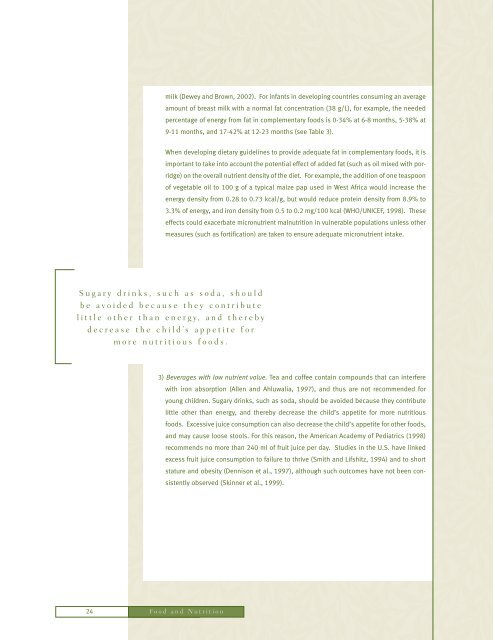Guiding Principles for Complementary Feeding of the Breastfed
Guiding Principles for Complementary Feeding of the Breastfed
Guiding Principles for Complementary Feeding of the Breastfed
Create successful ePaper yourself
Turn your PDF publications into a flip-book with our unique Google optimized e-Paper software.
milk (Dewey and Brown, 2002). For infants in developing countries consuming an average<br />
amount <strong>of</strong> breast milk with a normal fat concentration (38 g/L), <strong>for</strong> example, <strong>the</strong> needed<br />
percentage <strong>of</strong> energy from fat in complementary foods is 0-34% at 6-8 months, 5-38% at<br />
9-11 months, and 17-42% at 12-23 months (see Table 3).<br />
When developing dietary guidelines to provide adequate fat in complementary foods, it is<br />
important to take into account <strong>the</strong> potential effect <strong>of</strong> added fat (such as oil mixed with porridge)<br />
on <strong>the</strong> overall nutrient density <strong>of</strong> <strong>the</strong> diet. For example, <strong>the</strong> addition <strong>of</strong> one teaspoon<br />
<strong>of</strong> vegetable oil to 100 g <strong>of</strong> a typical maize pap used in West Africa would increase <strong>the</strong><br />
energy density from 0.28 to 0.73 kcal/g, but would reduce protein density from 8.9% to<br />
3.3% <strong>of</strong> energy, and iron density from 0.5 to 0.2 mg/100 kcal (WHO/UNICEF, 1998). These<br />
effects could exacerbate micronutrient malnutrition in vulnerable populations unless o<strong>the</strong>r<br />
measures (such as <strong>for</strong>tification) are taken to ensure adequate micronutrient intake.<br />
Sugary drinks, such as soda, should<br />
be avoided because <strong>the</strong>y contribute<br />
little o<strong>the</strong>r than energy, and <strong>the</strong>reby<br />
decrease <strong>the</strong> child’s appetite <strong>for</strong><br />
more nutritious foods.<br />
24 Food and Nutrition<br />
3) Beverages with low nutrient value. Tea and c<strong>of</strong>fee contain compounds that can interfere<br />
with iron absorption (Allen and Ahluwalia, 1997), and thus are not recommended <strong>for</strong><br />
young children. Sugary drinks, such as soda, should be avoided because <strong>the</strong>y contribute<br />
little o<strong>the</strong>r than energy, and <strong>the</strong>reby decrease <strong>the</strong> child’s appetite <strong>for</strong> more nutritious<br />
foods. Excessive juice consumption can also decrease <strong>the</strong> child’s appetite <strong>for</strong> o<strong>the</strong>r foods,<br />
and may cause loose stools. For this reason, <strong>the</strong> American Academy <strong>of</strong> Pediatrics (1998)<br />
recommends no more than 240 ml <strong>of</strong> fruit juice per day. Studies in <strong>the</strong> U.S. have linked<br />
excess fruit juice consumption to failure to thrive (Smith and Lifshitz, 1994) and to short<br />
stature and obesity (Dennison et al., 1997), although such outcomes have not been consistently<br />
observed (Skinner et al., 1999).

















